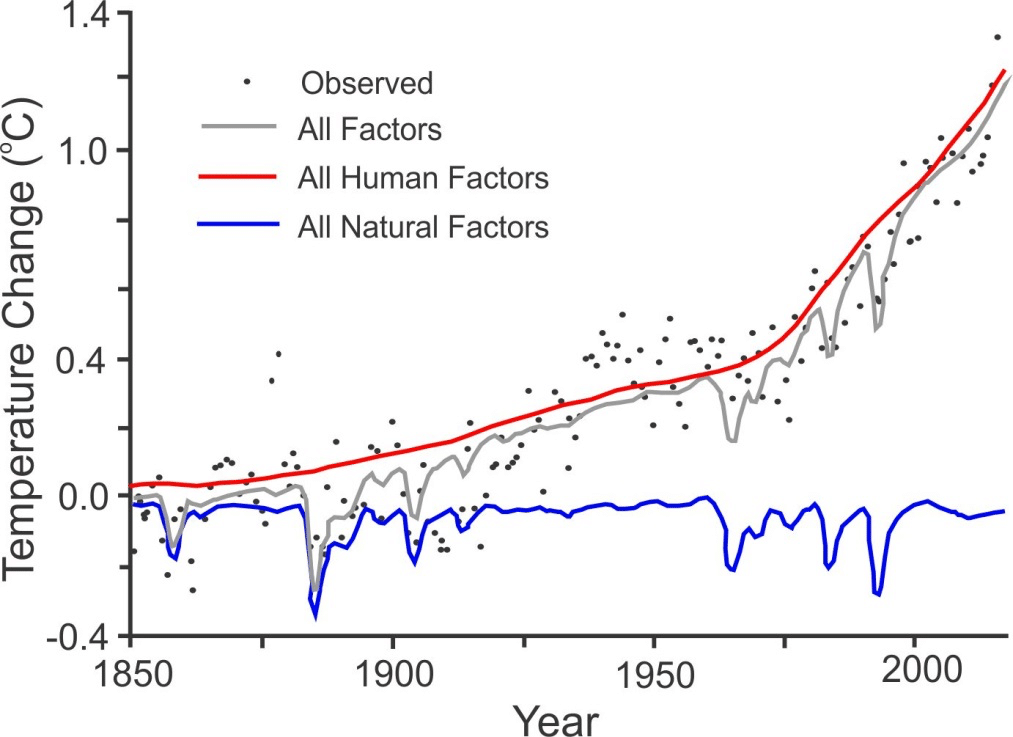Climate change is probably the gravest threat facing humanity today. Indeed, not only for humanity, but for all the myriad of species which have prospered in the climatic conditions prevalent at this stage of our planet’s evolution.
In the Earth’s history there have been many species and species extinctions, and we have to decide whether we, as such a species, want to continue living on a planet where we have adapted rather well to conditions. Or if we would rather choose an unknown climatic future where adaptation is going to be difficult, because the available evidence shows humans have a major part to play in the manner in which the Earth evolves further.
Global warming is one aspect of climate change – albeit a very important one – and air temperature can act as a proxy for more complex climatic processes. Nonetheless, it is important to note that actual temperature measurements only became possible in the last two centuries, and our records of older temperatures are derived from temperature-related characteristics of materials such as ice cores, pollen, tree rings, etc.
At the start we need to have a basic understanding of environmental and climatic processes involved in establishing global temperatures.
The Greenhouse Effect
All objects with a temperature above absolute zero (-273.15 °C) emit electromagnetic radiation. The spectrum of this electromagnetic radiation extends from low energy microwaves and infrared light (longer waves) through the visible part of the spectrum that we see as light, and then to more energetic forms such as ultraviolet and x-rays (short waves).
The spectrum of emitted radiation depends upon the object’s temperature. The higher the temperature, the shorter the wavelength, and the more energetic the light.
Ignoring geothermal effects, the Earth’s temperature is determined by the radiation it receives from the sun. The sun has an average surface temperature of around 6,000 °C and primarily radiates visible light, which we see as sunlight.
About 29% of this incoming solar radiation is reflected by the Earth and its atmosphere. At the same time the atmosphere also absorbs about 23 % of this sunlight, while the Earth’s surface absorbs another 48 %. In order for the Earth’s average temperature to remain stable, this much radiation must also be radiated back into space.
The surface of the Earth has an average temperature of about 15 °C, so it radiates in the infrared part of the spectrum, with a much longer wavelength than the incoming solar radiation.
Fortunately the Earth’s atmosphere contains gases such as water vapour, carbon dioxide, methane, and nitrous oxide. These molecules are called “greenhouse gases” because they have a very special property: they do not absorb the visible light from the sun, but they do absorb the infrared radiation from the Earth’s surface.
If greenhouse gases were not in the atmosphere, all the infrared radiation emitted by the Earth would go back out into space, leaving the Earth too cold for life. But the greenhouse gas molecules absorb the infrared light, warming the atmosphere and then they re-radiate some of it back to the Earth’s surface. This makes the surface hotter so it radiates more light, establishing an equilibrium at a higher temperature. This process is known as the Greenhouse Effect.
The more greenhouse gases in the atmosphere, the higher the equilibrium temperature.
Climate Variability
Climate variability, and in particular temperature variability, is a common feature in the Earth’s history, and Figure 1(a) demonstrates this variability over the last 800,000 years. Substantial climate changes occurred, with carbon dioxide and temperature following each other closely. The substantial peaks and troughs approximately every 100,000 years are the Milankovitch cycles due to changes in the earth rotation and orbital characteristics.
The emergence of homo sapiens is shown over the last 200,000 or so years. They underwent substantial privations during the last ice age, with recent evidence that the majority survived on the South African south coast.
The period in the little red circle is expanded in Figure 1(b), and shows temperature variability over the present interglacial period. The last half of it essentially constitutes our entire period of civilisation.
Even here there are temperature variations which had important consequences. The medieval warm period in the North Atlantic lasted for a few centuries about 1000 years ago, with temperatures rising by some 1 °C. It appears not to have been a global event, though the Vikings took advantage of conditions to colonise southern Greenland and to journey to Newfoundland.
The little ice age followed around 1500 AD, again lasting for a few centuries. Temperatures fell by around 0.6 °C, with cold and prolonged winters reducing the growing season by several weeks, leading to widespread crop failure, famine, and in some regions, population decline. Frost fairs were held on the frozen Thames.
Present Variability
Before the Industrial Revolution started in the mid-1700s, the global average carbon dioxide concentration in the atmosphere was about 280 ppm, while Figure 1(a) shows that during the past million years or so carbon dioxide never exceeded 300 ppm. Since then human activities have been releasing carbon dioxide into the atmosphere at an increasing rate, and at the moment it stands at over 410 ppm; it hasn’t been this high for millions of years.
In the last few decades we have made enormous strides in measuring conditions on Earth, in particular using satellite technology. We have been getting increasingly sophisticated data on processes affecting all parts of our planet, and at the same time our understanding of how all these processes interact has increased by leaps and bounds. This has enabled improved numerical models to be developed encompassing more parameters and shorter spatial and time scales.
All in all it means that we are getting much better at understanding and simulating the natural world, and therefore also in predicting future outcomes.
The greenhouse gas effect was first described in the 19th century and global temperature data has identified a warming trend since the mid-1970s. The recorded warmest 10 years globally have all occurred since 2005, with 2020 the hottest year on record, tying with the previous record in 2016.
However, with all the natural variability the increasing temperatures cannot necessarily be related to increasing human-produced carbon dioxide concentrations. Because of the complexities involved, in the past climate models have shown a wide spread of uncertainty, and it is only recently that a better understanding of the processes, better data and better models have enabled more decisive conclusions to be reached.
An analysis of recent results is shown in Figure 2. In particular, it is apparent that without the additional carbon dioxide pumped into the atmosphere by human activities, the Earth’s climate would not have changed appreciably over the last 150 years. The scenario now is one of rapidly increasing global temperatures.
Some 97 to 98% of actively publishing climate scientists support the consensus on anthropogenic climate change, namely that human activities releasing carbon dioxide into the atmosphere are responsible for global warming. UN Secretary-General António Guterres has stated that “Climate change is moving faster than we are. We must listen to the Earth’s best scientists.”
Of course the consequences are much greater than just global warming. The oceans have warmed, expanded, and with melting glaciers, are causing sea level rise. The increasing ocean temperatures and acidification from absorbed carbon dioxide are destroying ocean habitats such as coral reefs.
Weather-wise there will be changes in rainfall patterns, with more droughts and heat waves, and it is important to note that many vulnerable people are dying in these heat waves. Hurricanes will become stronger and more intense. Climate change will influence ecosystem functioning and thus the biodiversity of plants, animals and other forms of life. Species extinction will increase. Warmer temperatures are also likely to affect the spread of infectious diseases, since the geographic ranges of carriers, such as insects and rodents, are often limited by climatic conditions. Agricultural productivity will increase in some areas and decrease in others.
On the human side environmental refugees will increase as people move to survive, and this will lead to conflicts over scarce resources.
According to Intergovernmental Panel on Climate Change, ‘(taken) as a whole, the range of published evidence indicates that the net damage costs of climate change are likely to be significant and to increase over time’.
So, yes, anthropogenic climate change matters, and it is impacting on our lives at present, and will do so even more in the future.
Figure 1(a) Temperature change (light blue) and carbon dioxide change (dark blue) over the last 800,000 years (NOAA National Centers for Environmental Information).
Figure 1(b) Temperature variability over the last 12,000 years.

Figure 2. Observed global mean surface temperature changes for the period 1850 to 2017 are shown by black dots, while the blue line depicts the modelled influence of all combined natural factors. The red line shows the effect of human activities, while the grey line shows the combination of all natural and human activities (Analysis: why scientists think 100% of global warming is due to humans. Carbon Brief, 2017).

The views of the writer are not necessarily the views of the Daily Friend or the IRR.
If you like what you have just read, support the Daily Friend

